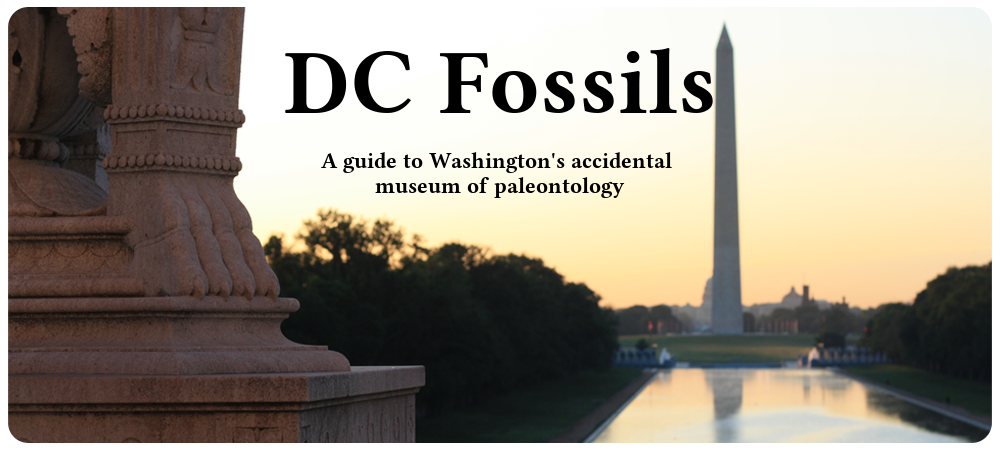Introduction
The Massangis Limestone
About the Fossils
Acknowledgments and Sources
M St., Georgetown, runs along a shelf of land above the Potomac River and is known as the heart of the oldest historic district in Washington. Yet, among its storefronts are a number of modern buildings. One newer addition stands at the northeast corner of 33rd and M St., N.W., just to the left of the green-roofed shell of a former Little Tavern. Note the building with the short tower:
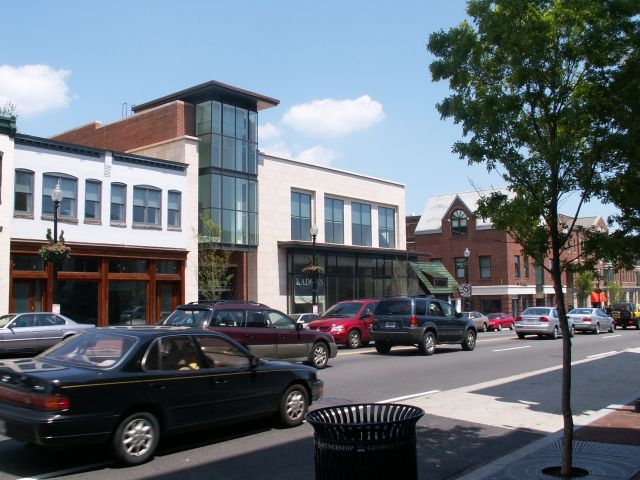
This new glass and limestone building, 3333 M St. was built in 2005 after its owners razed its predecessor, 3339 M St. The city found the former building, a 1919 brick structure, to be “not a contributing element to the Old Georgetown Historic District,” because it was “outside the period of significance for the Historic District.” In contrast, the city found that the new building would provide “a significant upgrade to the badly run-down site,” with more parking – no small point in Georgetown. (The city noted that the project would create “a major increase in the amount of on-site parking spaces, well above what has typically been done in Georgetown.”)
The exterior of the new building contains limestone panels whose origins long predate the period of significance for the Historic District and the 1751 founding of Georgetown itself. Originally, the architects proposed to use the Jura Gelb limestone seen in Gallery 9 – a stone rich with fossils from southern Germany of the Jurassic. Chance then intervened. At a public meeting to review the design, neighborhood attendees objected to the general appearance of the Jura Gelb. In response, the architects came up with another, different limestone, a stone commercially called “Massangis Roche Jaune Claire,” from France. That met with approval, and the building now displays the French limestone instead.
But it is still full of Jurassic fossils:
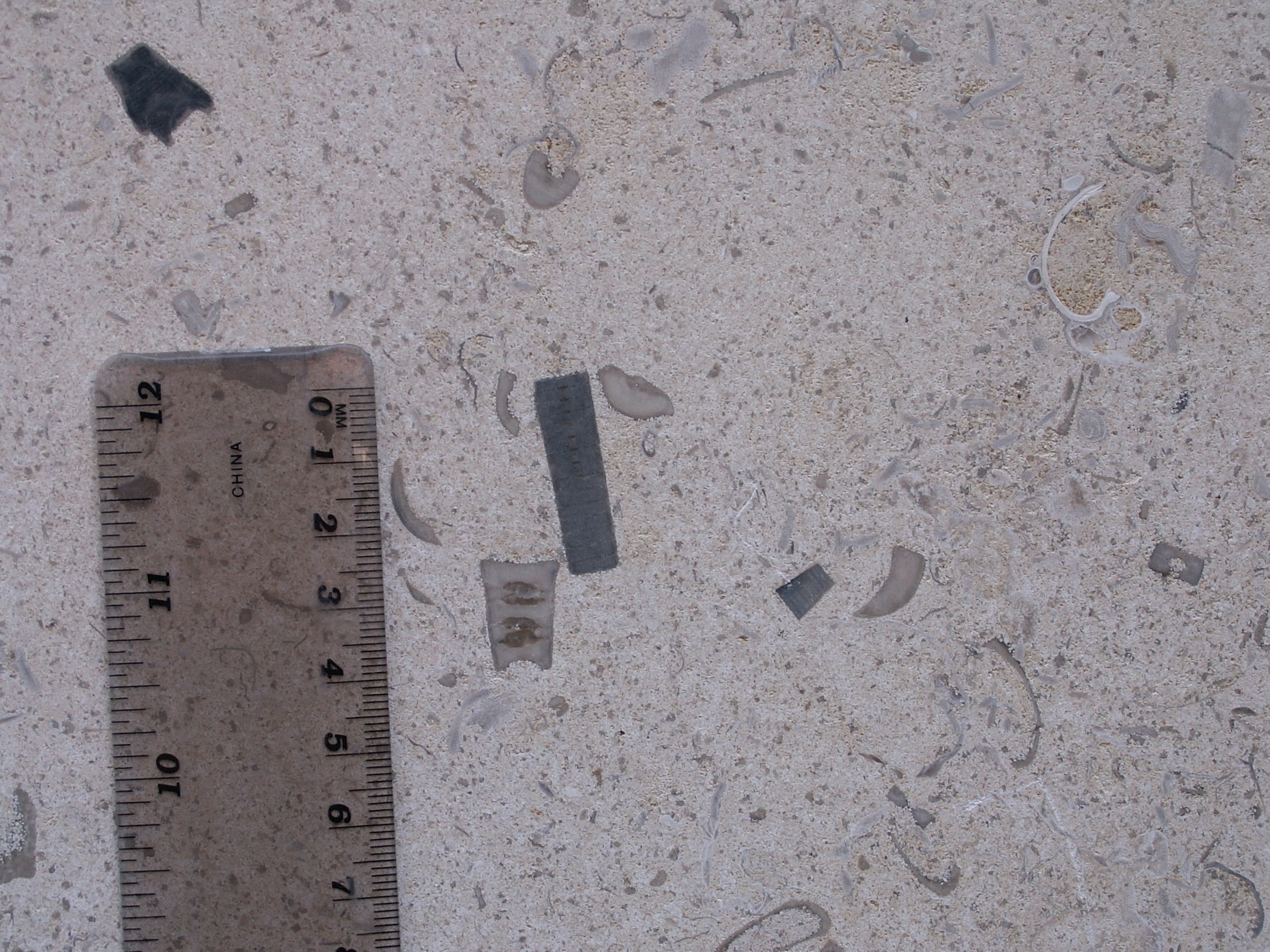
In fact, the fossil array in this stone, at first glance, at first glance resembles portions of the Jura Gelb in 2121 Pennsylvania Ave. Differences appear, however, even to the non-specialist’s eye. For example, the Jura Gelb has generally larger crinoid fossils and substantially fewer bivalve shell fragments.
So, aesthetic objections voiced at a public meeting led to the introduction of a new and different fossil assemblage in the heart of the city – a suitable entrée for this building into the Accidental Museum of Paleontology.
The stone, “Massangis Roche Jaune Clair” is a limestone quarried in the south of France from the Bathonian period of the Middle Jurassic, approximately 164 to 167 million years ago. It formed in a shallow marine environment where the Tethys Sea, a predecessor of the Mediterranean, lay just south of the land mass that later became Europe.
This limestone has become popular in D.C. within the past decade. In addition to this building, it can be found in the Nigerian Embassy on International Court, N.W., near the Van Ness subway stop (not a good viewing location), and in the striking new (2005) Katzen Arts Center of American University by Ward Circle, 4400 Massachusetts Ave., which has vast surfaces of the limestone available for public view (and an art museum).
Like the German Jura Gelb limestone, the massangis stone allows the use of a different texture, color and appearance from the still-popular Salem Limestone. Also like the German limestone, the Massangis Limestone has an important structural feature as well: it can be cut into usable dimension stone in significantly thinner panels than Salem Limestone – two inches thick rather than the traditional four inches needed for the Indiana stone. Thinner panels reduce the cost per square foot of building surface. Thinner panels also lessen the burden on the walls holding the panels, allowing the architects greater freedom in designing the structure. A significant rise in the use of imported limestone types, including German and French limestones, began in the 1980s and continues today.
At this point, the author has little specific information about the fossils. The Massangis Limestone merits its own Gallery because of its large and distinct images – particularly of crinoid fragments. A detailed discussion of crinoids is found in Gallery 9.
In this photograph, a clear “life-saver”-like crinoid columnal appears to the right of the ruler’s tip:
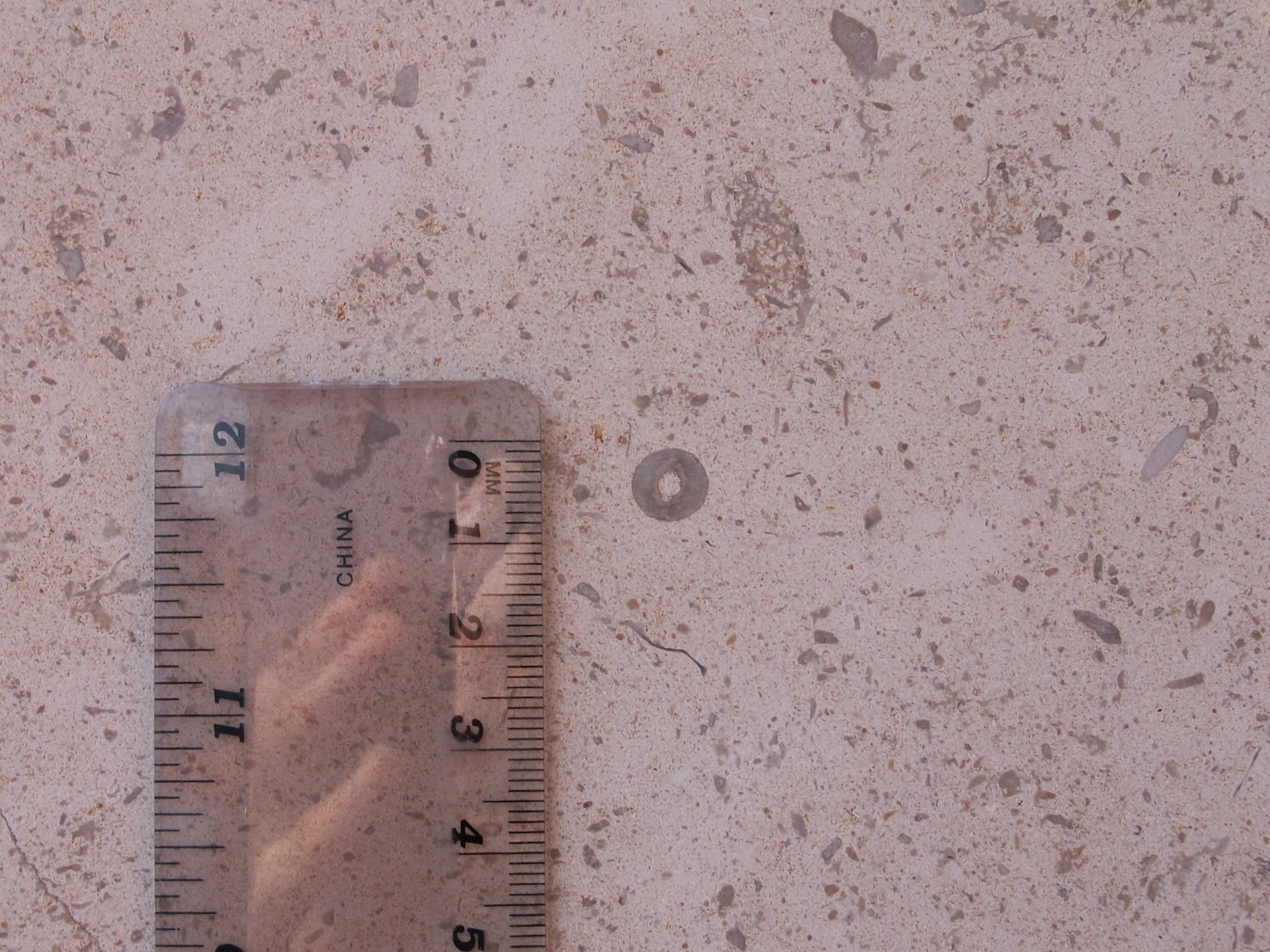
The dark grey shapes densely crowding the light tan matrix of the limestone are likely to be fragments of fossils.
In the photograph below, note the upright crinoid columnal next to the cross section of a crinoid stalk on its side, to the right of ruler’s end:
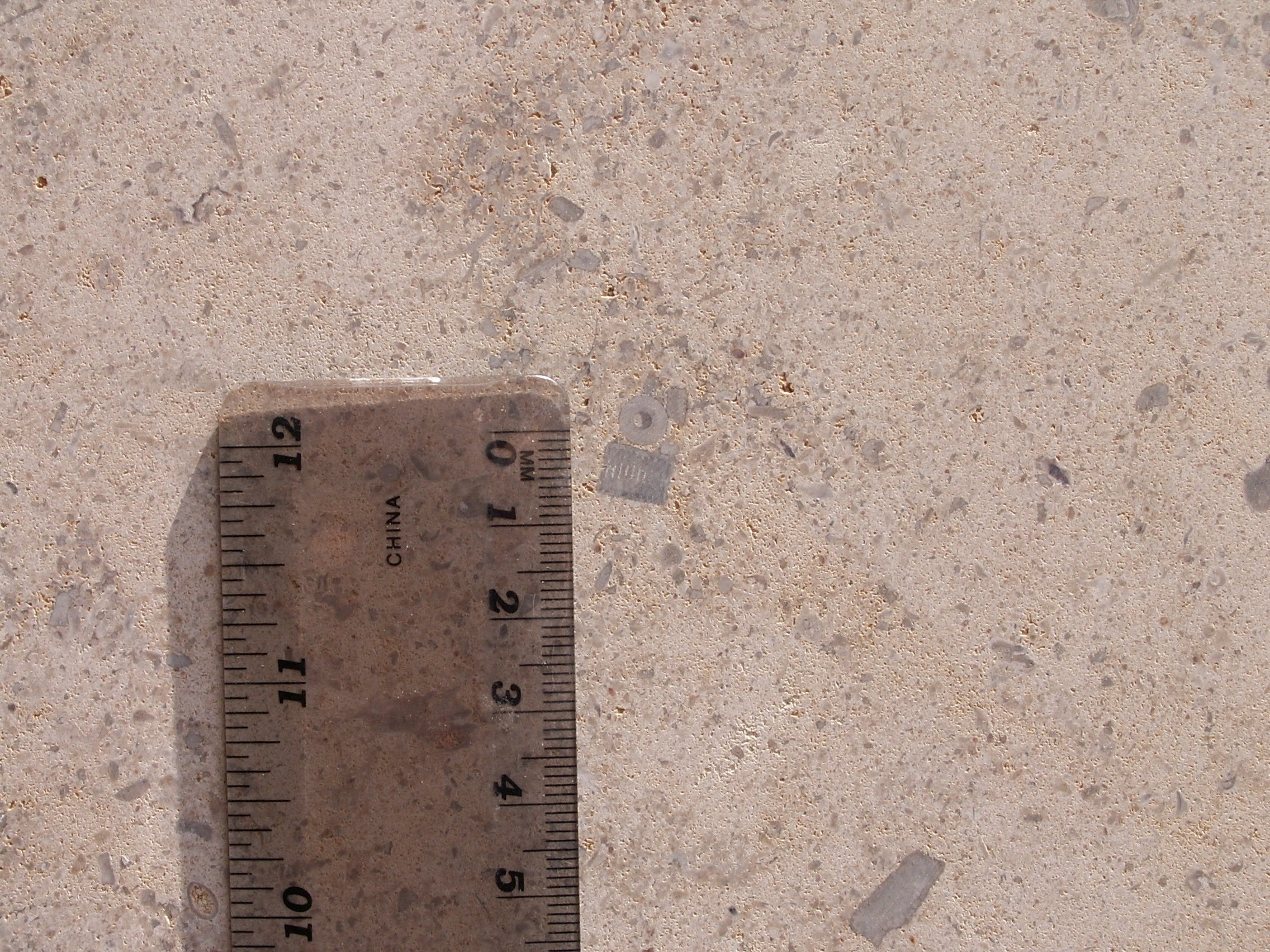
Contrast the narrow segments of the crinoid stalk in the picture above, with the very different crinoid stalk shown in cross-section on its side below:

In the photograph below, the axial canal of a crinoid stalk is clearly visible to the right of the 1.5 centimeter mark on the ruler, filled in with the calcite matrix of the limestone:
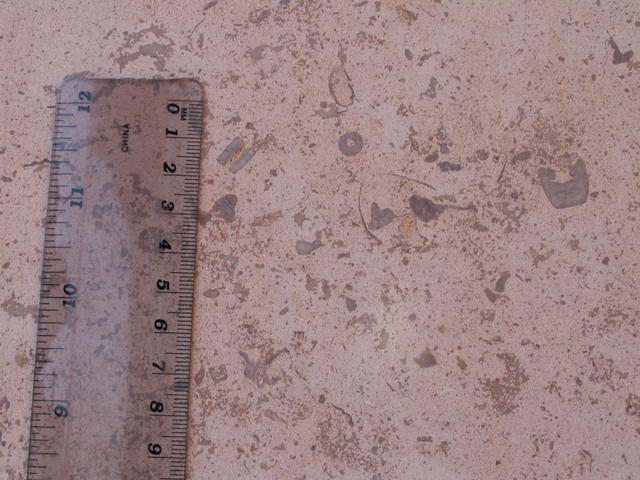
Note as well in the picture above thin curved lines that appear to be cross-sections of bivalve shells.
The photograph below appears to show the cross-section of a bivalve shell with pronounced radials – similar fossils can be found a number of other places in the panels:

Acknowledgments and Sources[1]
The identity of the stone was provided by the Commission of the Fine Arts, which has jurisdiction over this and nearby buildings overlooking the Key Bridge. The Commission also provided information about the proceedings in which the new structure was approved, including notes on the dispute over the type of limestone. Further detail on the reasons for approval of the razing and replacement of the original building is available from the decision of the Administrative Law Judge of the District of Columbia Department of Consumer and Regulatory Affairs, Office of Adjudication, HPA # 2000-31, Application for Alteration, Construction and Demolition Permits, 3331, 3339 and 3345 M St., N.W., March 17, 2000, available online at http://11.georgetown.edu/histpres/decisions/hpa2000-31.html
Information about the historic neighborhood is found in the pamphlet, “Georgetown Historic District,” by Tanya Edwards Beauchamp, D.C. Historic Preservation Office.
The age of the formation was provided by the website of the company in France providing the stone, Rocamat, at http://www.rocamat.fr/html-gb/f3.php?NUM_PIER=J3
Information about the stone and the selection process was also provided by personal communication from the architects, Shalome Baranes, and their stone supplier.
[1] Where this website cites specific internet page addresses, they are typically the addresses used by the author in researching and writing this discussion – a process taking several years. Unfortunately, in the meantime a number of the specific addresses have changed, and will continue to change, rendering some of these addresses ineffective as links. Readers should be able to find the material by searching for the proper name of the cited article or material on a search engine.
